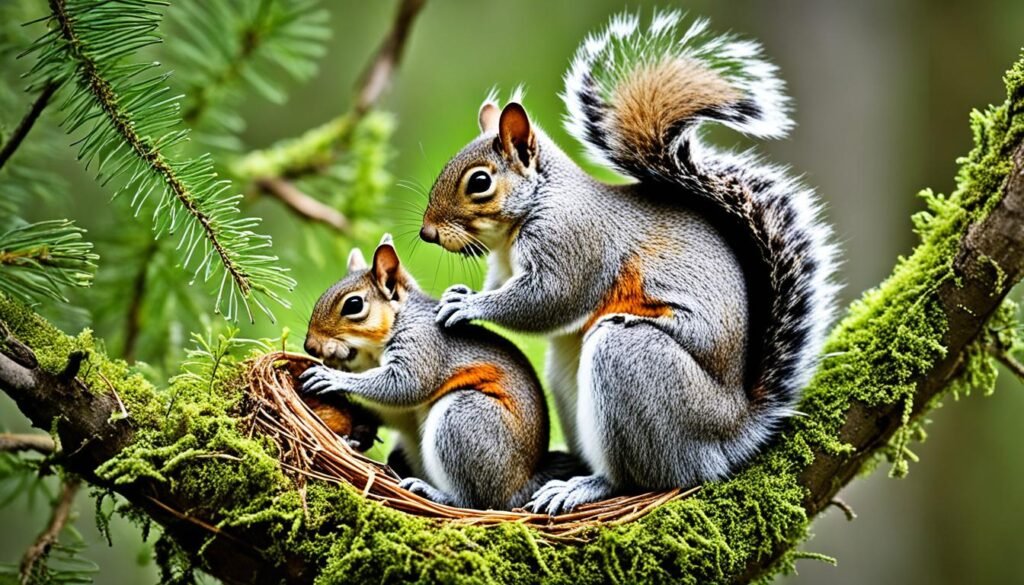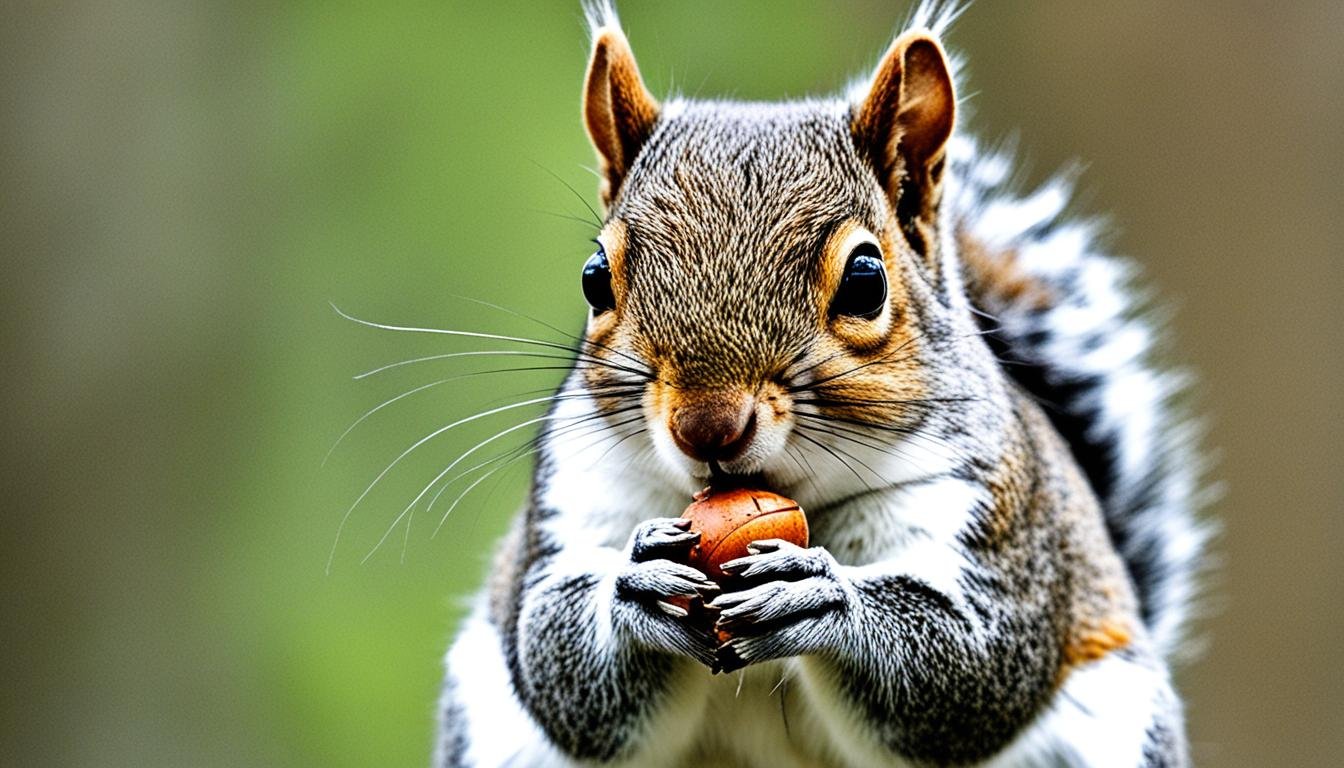Squirrels started their journey over 36 million years ago. This journey shows how they evolved from ancient ancestors to the many types we see today. Due to Earth’s changing climates, these nimble creatures spread into diverse areas worldwide. Exploring squirrel habitats gives us a great view into their successful adaptations.
Fox squirrels make leafy nests and are common, while some European forest dwellers are rare and considered invasive. Through DNA, researchers have traced how squirrels spread across continents. They moved from places like the forests between Alaska and Siberia to South America, helped by a land bridge at the Isthmus of Panama.
Learning about squirrels helps us appreciate their history and the need to protect their future. By looking closer at their habitats, we see the deep connection between species and their environments. This exploration sparks both curiosity and respect for these interesting creatures of the natural world.
Understanding the Sciuridae Family
The Sciuridae family, also called the squirrel family, includes about 280 species. These creatures are found almost everywhere in the world except Australia and Antarctica. People love them for their unique looks and behaviors.
The Diverse Squirrel Family
Squirrels fall into three groups: tree, ground, and flying squirrels. Each type has its own special traits. For example, tree squirrels have big bushy tails that help them climb and balance.
Ground squirrels have furry tails too and live underground. Flying squirrels glide through the night, using a special membrane. Besides eating nuts and seeds, some also eat fungi, insects, eggs, and little animals.
Squirrel Classification and Taxonomy
The study of squirrel classification and squirrel taxonomy shows how varied these animals are. They live in many parts of the world like the Americas, Eurasia, and Africa, fitting into local environments. North America has a wide variety of squirrel species.
In places like New Hampshire, some squirrels are endangered. This shows why saving their habitats is crucial.
Physical Characteristics of Squirrels
- Squirrels typically showcase slender bodies, bushy tails, and large eyes conducive to their active lifestyle.
- The dental formula of a squirrel is the structural key to its diet, featuring large incisors for gnawing and cheek teeth for grinding.
- In terms of size, they can range from the diminutive African pygmy squirrel at 10–14 cm to the impressive Bhutan giant flying squirrel, stretching up to 1.27 m in total length.
- Lifespan in the wild averages between five to ten years, with some species living up to two decades in captivity.
Squirrels have many ways to survive. They can be solitary or live in groups, be active by day or night. They’re smart about storing food and can adapt to living with humans. Some ground squirrels even hunt. These habits show how complex and interesting the squirrel family is, making them a top subject for research and protection.
| Type | Habitat | Behavior | Dietary Adaptations |
|---|---|---|---|
| Tree Squirrels | Arboreal, prefers forests | Diurnal/Crepuscular, bushy tails | Nuts, seeds, some omnivorous habits |
| Ground Squirrels | Various, including underground burrows | Diurnal/Crepuscular, colony or solitary | Omnivorous, includes plants, seeds, and sometimes protein from small animals |
| Flying Squirrels | Woodlands, uses gliding membrane | Nocturnal, navigates with gliding | Seeds, nuts, fungi, and fruits |
The Variety of Squirrel Species Worldwide
The world is full of different types of squirrels. We see them leaping among tree branches, digging in the ground, and even gliding through the air. Each type, from tree to ground to flying squirrels, shows how animals adapt and evolve. They come in many sizes, from the tiny African pygmy squirrel to the large Indian giant squirrel. This shows just how diverse the animal kingdom is.
Tree, Ground, and Flying Squirrels
Tree squirrels are amazing climbers. You can find the red and gray squirrels in the forests of North America and Europe. Ground squirrels make their homes by burrowing. They live in mountains and fields. Flying squirrels, however, are magical creatures of the night. They glide from tree to tree using a skin flap called a patagium.
- In Europe and Asia, red squirrels are widespread but you won’t find them in Iceland or the Mediterranean Islands.
- In England, red squirrels fill Kielder Forest with life and color.
- Grey squirrels, introduced in the UK in the 19th century, have found their place. They’ve affected where red squirrels live.
The Smallest and Largest Squirrel Species
Squirrels can be very small or very big. The African pygmy squirrel is as small as a pencil. In contrast, the Indian giant squirrel is as big as a toddler. Their size shows us how squirrels have adapted to their habitats. It also shows their role in nature – from spreading seeds to being food for predators.
- In the forests of Northumberland, active red squirrels move through trees. They are about 12 inches long.
- Grey squirrels, found in urban Massachusetts, are nearly 20 inches long. They eat a variety of plants.
Squirrels play an important role in nature. They also interact with humans, from being cute guests in our yards to sometimes being pests. Squirrels, whether they’re gliding, digging, or jumping, add to the diversity of our natural world. They help us understand nature’s complexity and remind us why we need to protect it.
The Peculiarities of Squirrel Diets
People often think squirrels only eat nuts. But their eating habits are much broader. With more than 200 kinds, squirrel diets vary widely. Each kind has its own foods it prefers, showing how they’ve adapted to different places. They eat more than just nuts. Their menus include many foods from their local areas.
Omnivorous Appetites: More Than Just Nuts
Squirrels enjoy a wide range of foods, not just nuts. For example, grey squirrels in North America eat nuts, fungi, seeds, and fruits. They even eat eggs, small insects, and young snakes sometimes. What squirrels eat depends on where they live. They must also watch out for predators like cats and foxes.
Food Storage and Seasonal Eating Habits
Squirrels prepare for winter by collecting and hiding food. This is seen in species all over, from Canada to Asia. They plan ahead for the cold months. Grey squirrels help grow new forests by forgetting where they buried acorns.
The seasons change what squirrels eat. Red squirrels eat more fungi in autumn. They switch to seeds and fruits in winter and spring. They like coniferous seeds too. Greys seem to prefer acorns, especially those with more nutrients.
Squirrels fit well into different places because of their varied diets. Their diets help them not just survive but also shape their environments. Looking at their diets and habits shows how complex and important they are to nature.
Squirrel Habitat: A Glimpse into Where Squirrels Live

Understanding squirrel habitat shows how well these mammals adapt and survive. Squirrels live in many environments, depending on what they need to thrive.
In the United Kingdom, red and grey squirrels live in different places. The red squirrel, pushed by grey squirrels, survives in coniferous areas. For instance, red squirrels are still plentiful in Northumberland’s Kielder Forest and areas near the England and Scotland border.
| Location | Red Squirrel Population | Black Squirrel Population | Grey Squirrel Population |
|---|---|---|---|
| Scotland | 121,000 | N/A | N/A |
| England | 30,000* | 25,000† | Outnumber reds 60 to 1‡ |
| Wales | 10,000 | N/A | N/A |
*Grey squirrels are tough competition
†Black squirrels have strong colonies in certain areas
‡Black squirrels are a growing threat
Black squirrels, a variation of grey squirrels, are changing habitats in England. Found mainly in counties like Hertfordshire and Bedfordshire, they are becoming more common.
In New England, the USA, squirrel habitat varies widely as well. Here, grey squirrels and red squirrels are common in different forests. The Southern flying squirrel is known for its night-time gliding.
Squirrel fur color matters for their survival. It helps them blend in and face seasonal changes. In places like New England, the variety of trees affects their diet and behavior.
Teaching kids about where squirrels live helps them connect with nature. Activities like nature walks or story writing allow them to learn and appreciate wildlife.
Learning about squirrel habitats helps us understand and protect these creatures. It highlights how their living conditions are vital not only for squirrels but for the whole ecosystem.
Architects of the Trees: Nests and Tree Dwellings
Tree squirrels are known as the top architects of our forest tops, making homes that are wonders of design. These skilled creatures make squirrel nests, or dreys, vital for their survival. They build in trees like oaks and maples, where food is plenty.
The Intricate Design of Squirrel Nests
Squirrels show great skill in making their nests. They create a big shell and a cozy chamber inside. The chamber is lined with grass and bark to keep them warm and safe. This smart architecture guards against predators and bad weather.
Tree Squirrels and Their Arboreal Havens
Squirrels make nests to live in, but they also build extras for safety. They use these extra dreys as safe spots or during food shortages. In winter, mates share nests. In spring, females raise their young in these homes, during their main nesting time.
In fall, squirrels get busy building nests for winter. They might also build in places like sheds or bird feeders, showing they’re good at finding homes. Squirrels live in many places, proving they can adapt to different environments.
While squirrel nests add beauty to trees, they can be a problem. Grey squirrels might chew on wires, causing fires. They can also carry diseases. Managing squirrel numbers and making nest boxes can help them and our ecosystems.
The Burrowing Lives of Ground Squirrels
Under grasslands and forests, ground squirrels have an amazing underground life. They make underground tunnels that are both homes and paths for finding food. These smart rodents are part of the Sciuridae family. They have interesting ways to live in different habitat regions. Ground squirrels live both above and below the ground. They change how they live throughout the year, including when they hibernate in winter.
Underground Tunnels and Winter Hibernation
Ground squirrels are great at making large underground tunnels. They use these for safety from predators and bad weather, and to raise their young. The tunnels have many exits to quickly get away. As winter comes, they hibernate. Their body slows down a lot to save energy. This special skill helps them live where winters are cold and food is hard to find.
Habitat Regions: From Grasslands to Forests
Ground squirrels live in many different habitat regions. They are in grasslands, meadows, and forests. Each place has different challenges and things they need. In city parks and yards, they sometimes cause trouble. Their digging can harm plants people grow. Still, with good management like Sprague’s Integrated Pest Management (IPM), they can be a part of nature without too much problem for people.
There are many types of ground squirrels. They come from the Genus Spermophilus and Genus Atlantoxerus. They are different in size, color, and what they do. Sprague Pest Solutions knows they are important to nature. They work to keep ground squirrels and human activities in balance. This shows how managing pests carefully is good for the environment.
The Magical Gliders: Flying Squirrels and Their Adaptations
Flying squirrels are amazing with their skill to glide from one tree to another. They have evolved in unique ways that let them fly through the air. These night-time animals came from tree-living ancestors around 25-30 million years ago. They kept some old squirrel traits and gained new ones for gliding.
Flying squirrels didn’t change much in shape or size like birds or bats did. Their ability to glide shows how they’ve balanced evolution to keep moving easily on the ground and in the air. While other animals had to get smaller to fly, flying squirrels kept different body sizes. This is thanks to their long limbs.
- Longer limbs help bigger flying squirrels glide better, putting less limit on how their body size evolves.
- Even with their gliding skill, flying squirrels have a range of body sizes and features like other squirrels.
- Studies show evolution doesn’t always mean more diversity, as seen with flying squirrels.
Flying squirrels and other tree-living creatures have complex brain adaptations. They have a higher Phylogenetic Encephalization Quotient (PEQ) than underground animals. This suggests they’re smarter, which helps them navigate and survive in the trees.
| Locomotor Group | Phylogenetic Encephalization Quotient (PEQ) | Petrosal Lobule Volume % | Neocortex Size |
|---|---|---|---|
| Arboreal | High | Significantly Higher | Larger |
| Gliding | High | Comparably Lower | Larger |
| Scansorial | Moderate | Significantly Bigger | Similar to Extant Squirrels |
| Fossorial | Lower | Lower | Smaller |
In conclusion, flying squirrels and their adaptations show how nature innovates. It’s a great example of how species use their environment to survive in different places.
Reproduction and Lifecycle of Squirrels

The journey of a squirrel’s life starts uniquely for each species, with mating and then raising their young. These steps are key to know if you want to understand how squirrels live and survive. The way these animals grow shows their amazing ability to adapt.
Gestation Periods and Birth of Kits
Squirrels carry their young for different times, but usually for a few weeks. When the babies, called kits, are born, they can’t see and need their mom a lot. Squirrel moms can have 2 to 8 babies at one time. In some types of squirrels, mothers can have more than one group of babies in a year. This helps there be more squirrels out in the world.
How Squirrels Care for Their Young
Caring for their young shows how strong and adaptable squirrels are. Mother squirrels feed their babies in safe homes and teach them how to find food. These first months are when baby squirrels learn everything they need to make it on their own.
From the start to when they’re all grown up, squirrels do amazing things to keep their family line going. By looking at facts and figures, we see how their life starts, how they grow, and how careful they are as parents. These things are all important to the life story of these amazing animals.
| Squirrel Type | Gestation Period | Average Litter Size | Weaning Age |
|---|---|---|---|
| Tree Squirrels | 38-46 days | 3-4 kits | 10 weeks |
| Ground Squirrels | 24-36 days | 5-8 kits | 6 weeks |
| Flying Squirrels | 40-65 days | 2-3 kits | 8-10 weeks |
Conservation Status of Various Squirrel Species
The path to protect squirrels is full of challenges. Species worldwide face losing their homes, climate change, and harms caused by people. Knowing if squirrel species are endangered helps us shape their future. Every action to save them is crucial for keeping our planet’s wildlife rich. It’s important to identify the endangered squirrels that need our help now.
Let’s look closely at endangered squirrels and how we protect them:
| Species | Location | Threats | Conservation Measures |
|---|---|---|---|
| San Joaquin Squirrel | California, USA | Habitat fragmentation, Agriculture | Protected Areas, Habitat Restoration |
| Red Squirrel | United Kingdom | Competition with Grey Squirrels, Disease | Conservation Programs, Controlled Culling |
| Mt. Graham Red Squirrel | Arizona, USA | Wildfires, Climate Change | Captive Breeding, Fire Management |
| Delmarva Fox Squirrel | Delmarva Peninsula, USA | Urbanization, Predation | Reintroduction Efforts, Habitat Conservation |
Understanding squirrel species’ conservation status helps us. It directs our actions to where they can really make a difference. Saving squirrels is about preserving our world for the future, not just one species. By knowing the risks, we can work together and make smart choices to protect them.
In facing the challenges endangered squirrels go through, we mustn’t lose hope. By working together, we can change their fate. Saving squirrels is vital. It helps not just the squirrels but the health of our entire planet.
Squirrels’ Behavioral Patterns and Communication
Squirrels have complex behaviors and ways of talking to each other. This helps them live well in their homes. When we learn about how they act, it shows us how they find their way in the world. This is especially true for Douglas’s squirrels.
Warning Calls and Scent Marking
Squirrels make sounds to warn others of danger. These calls tell others about nearby predators like northern goshawks and large owls. They make everyone either hide or run away. Squirrels also use smells to mark their space. This tells other squirrels which parts of the forest they claim as theirs. These smell messages are key to keeping their area safe all year.
Interactions and Territorial Defense
Douglas’s squirrels are very good at protecting their space. This is most important in autumn when they gather food for winter. They stay in the same place all year, from the green lands of British Columbia to the Sierra Nevada.
They use their tails for balance, warmth, and sending messages. With sharp claws and strong muscles, they move easily through trees. This helps them guard and control their area.
| Characteristic | Description |
|---|---|
| Territorial Defense | Douglas’s squirrels intensely defend their territories, particularly in the fall. |
| Physical Adaptations | Equipped with sharp claws, powerful legs, and flexible hind joints to navigate trees. |
| Gestation and Offspring | Average of 4 kits born blind and naked after a 5–6 week gestation period. |
| Size | Can grow up to 37 cm in length, including the tail. |
| Habitat Range | Inhabits conifer forests year-round, from British Columbia to the Sierra Nevada. |
The Impact of Squirrels on Ecosystems
When we look at how squirrels affect ecosystems, it’s really interesting. They do more than just live in our backyards. These animals are key to keeping forests healthy and full of life. They play a big part in the ecosystem, especially with planting trees through seed dispersal.
Seed Dispersal and Environmental Contributions
Squirrels impact their homes by burying seeds. This habit helps grow many kinds of trees, shaping the forest. By doing this, they help the environment. They boost the variety of plants and renew the forest.
In Florida, different types of squirrels are very important. For example, the gray squirrel helps the long-leaf pine trees survive. This is essential for keeping a home for many animals.
Squirrel-Induced Tree Planting
The idea of squirrel-induced tree planting shows their importance to nature. They hide seeds to eat later, but often forget them. These seeds can grow into new trees, making the forest larger and more varied.
Scientists are studying why squirrels decide to save or eat seeds. This helps us understand their effect on tree diversity. The decreasing numbers of colorful fox squirrels, unlike the common gray ones, worries us. It’s important to keep studying squirrels to help all types survive well. They’re crucial for things like spreading seeds and shaping the forest.
Conclusion
Squirrels show us how to live in different places. They can live in big forests or city parks. These animals adapt well and show the beauty of nature’s variety. They have long bushy tails and big eyes which many people love.
Their diets are amazing because they eat plants, nuts, seeds, and even bugs. Sometimes, they even eat other small animals. Squirrels use their tails for balance and to talk to each other. They help plants grow by spreading seeds around.
Some squirrels are very small, and others are much bigger. But all of them face challenges, like losing their homes. Despite this, squirrels still play a big role in keeping nature healthy.
We learned about how squirrels live and how they help the environment. We saw they live together on the ground or by themselves in trees. This reminds us to help protect nature. Squirrels help scientists learn more and remind us to care for our world.
FAQ
What are the different types of squirrels found worldwide?
Worldwide, you can find tree squirrels, ground squirrels, and flying squirrels.
What is the smallest squirrel species?
The tiniest squirrel is the African pygmy squirrel. It’s also known as the least pygmy squirrel.
What is the largest squirrel species?
The biggest squirrel is the Malabar giant squirrel. People also call it the Indian giant squirrel.
What do squirrels eat?
Squirrels are not picky eaters. They enjoy nuts, seeds, fruits, fungi, insects, and small animals.
Where do squirrels live?
Squirrels make their homes in forests, urban parks, and more. They like tree tops and underground burrows.
How do squirrels build their nests?
Squirrels use twigs, leaves, and other items to build their nests. They place them high in trees.
What are the burrowing habits of ground squirrels?
Ground squirrels dig tunnels underground for shelter. They stay in these burrows during winter.
What are the unique adaptations of flying squirrels?
Flying squirrels have a special skin flap that lets them glide. This flap is called a patagium.
How do squirrels reproduce?
Squirrels have babies called kits after mating. How long before they’re born depends on the squirrel type.
What is the conservation status of squirrel species?
Many squirrels face danger because their homes are destroyed. People are working to save these species.
How do squirrels communicate?
Squirrels use calls and scents to talk. They warn others of danger and claim their area.
What is the impact of squirrels on ecosystems?
Squirrels are key in spreading seeds, which helps forests grow. They unknowingly plant trees when they hide seeds.














